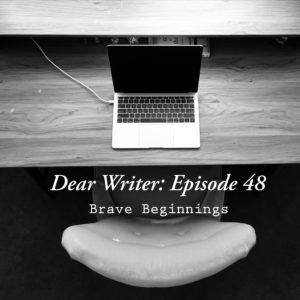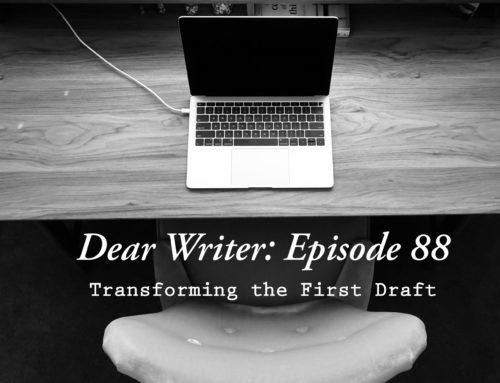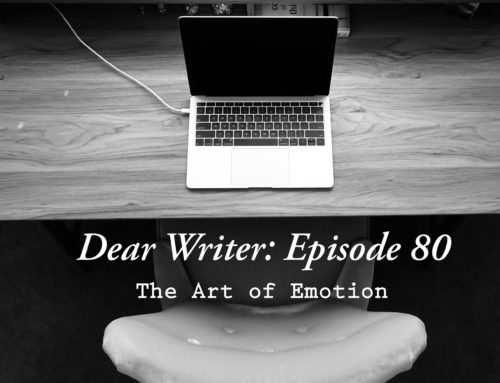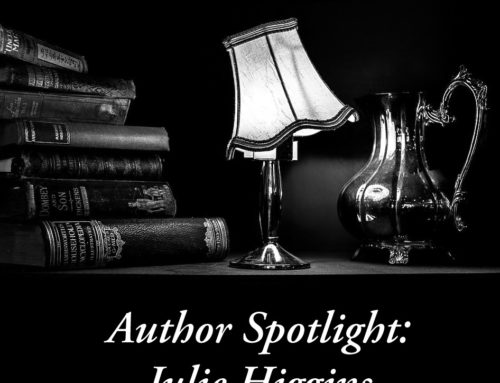Brave Beginnings
This week for our main episode on Dear Writer, we explored beginnings. We focused on the first sentence, the first paragraph, the first chapter, the introduction of your protagonist, and even went as far to talk about how you might plan to write the first book of a series.

Episode Summary
To begin, we looked at the very first sentence of a novel and discussed what we believed a great first sentence should include. Both Sarah and Ashley agree that the biggest task of a first sentence is to draw readers in. Ashley mentioned that a good first sentence causes the reader to ask questions and gave several examples from our teen fiction series.
“New Zealand used to be a place where people wanted to live.” — When the Rain Falls
“Home was the last place I wanted to be.” — The Price of Pandemonium
Sarah pointed out that while the first two of these examples worked well, it was because they raised questions, and were short, punchy, powerful lines. The third example, shown below, demonstrates a failed opening sentence:
“It was a damp New Zealand winter when the first omen of war came rolling to my doorstep.” — Darkness, Set Us Free.
We discussed that this sentence was likely too long, and failed to raise questions. Especially considering it is the third book in the series and presumably most readers know this information already. It also highlighted a major point Ashley and Sarah both agreed upon—how pivotal it is to go back and rework your opening scenes.
We next talked about the opening paragraph, and how to continue from the great opening line into an intriguing opening scene. This is done by continuing to build on the questions raised in the first sentence, and by providing the ‘voice’ that suits the protagonist and sets up the narrative tone of the book. In the first paragraph it is important to build atmosphere and the setting. When it comes to setting, the unique culture of a place (rather than something such as weather) is most important to get across, so the scene is built in the reader’s mind. Sarah mentioned it is sometimes a good idea to make links from the beginning that later resonate through to the ending, which can give the book a sense of completion. She also talked briefly about beginning the next book of a series. It is important to ensure that the beginning of the next book links (however loosely) with the ending of the previous one. This means considering what an appropriate point of time is to start your next book. For example, a book that ends in a cliffhanger should be directly followed by the next. If there is a gap in time, the readers will feel cheated out of the cliffhanger’s resolution.
The next natural place to continue was by discussing the first chapter, and what we think are crucial elements of the first chapter. Ashley believes that the first chapter must introduce the protagonist, the setting, and include a life-changing event (the inciting incident). Sarah did mention that the pace of the book is going to be dependent largely on the type of genre you are writing, so getting familiar with books in your genre is key, as some genres allow for slower and more gradual openings than others. Sarah thought a ‘status quo’ needs to be set for the protagonist to allow for greater contrast when the inciting event happens, and even if the inciting event doesn’t come in the first chapter, hints of the things wrong with the protagonist’s life need to be introduced. There has to be a reason why this exact point of time was chosen in the character’s life to start the story.
One of the major elements in the first chapter is being introduced to the protagonist(s). Ashley said she thinks (for most stories) it’s important to introduce the main character(s) as soon as possible. And this includes taking the character’s emotions and feelings into account right from the beginning of the book. This is why it’s sometimes easier to go back and revisit the first few chapters after writing the novel—you know your characters much better by the end of the book so it is easier to ‘get inside their heads’. Sarah mentioned how the character relates through narration, their actions and their speech can give a sense of their age to the target readers. Occasionally a book will be marketed as ‘adult fiction’ but is really in the realm of young adult or even juvenile fiction. If you struggle with this, she suggested reading some books on childhood development to better understand what a child is able to comprehend versus a teen, versus an adult.
Finally, we went over what a first book might look like in a series. Sarah took the lead on this question, using story structure to explain how an overall story arc can also be applied to a whole series. She discussed the three main sections of a story arc: The beginning hook, the middle build, and the ending payoff. While every book must fulfill these requirements on a smaller scale, it can also be applied on a broader scale to an entire series. The example she uses is a trilogy, where the first book becomes the ‘beginning hook’ to the wider series, with a broad inciting incident being introduced over the first book and the character’s reaction to this life-changing event. The second book in the series becomes the ‘middle build’ with victories and losses as the character attempts to solve the overall problem, and the third book becomes the ‘final payoff’ where the character either wins or loses their fight to bring order back into their life.





















Leave A Comment